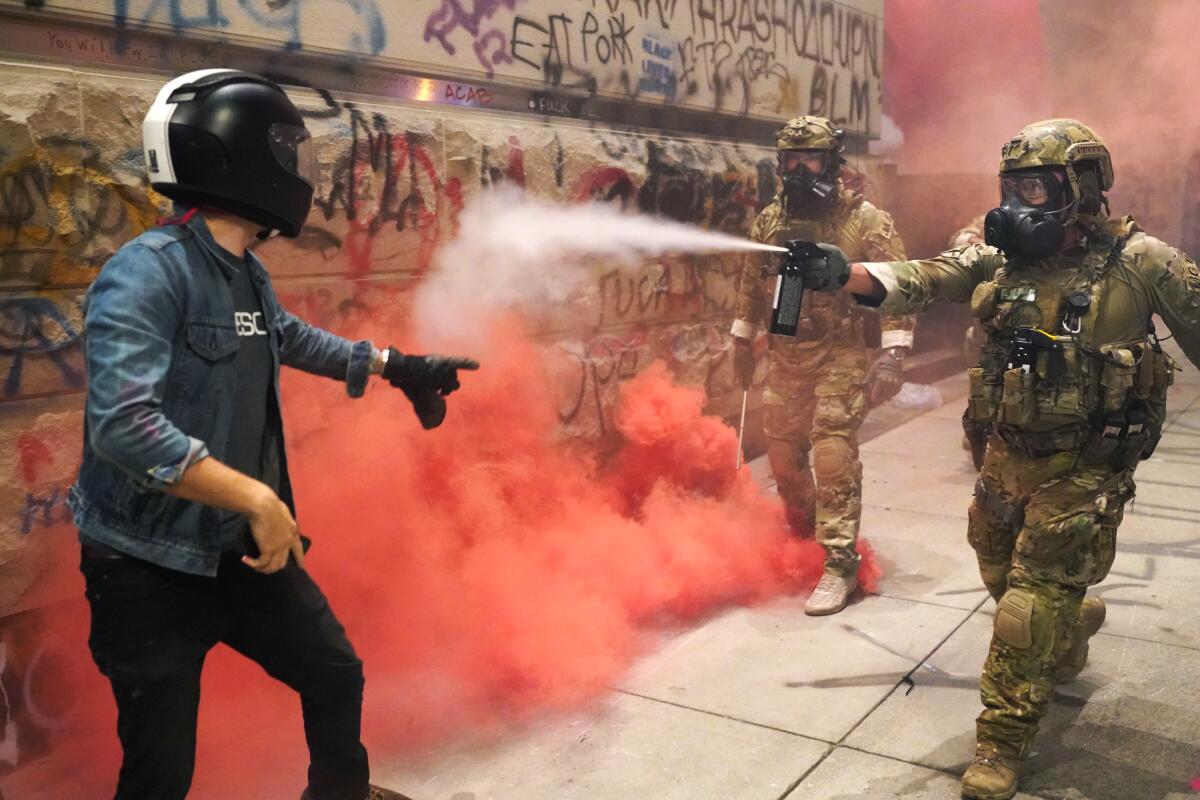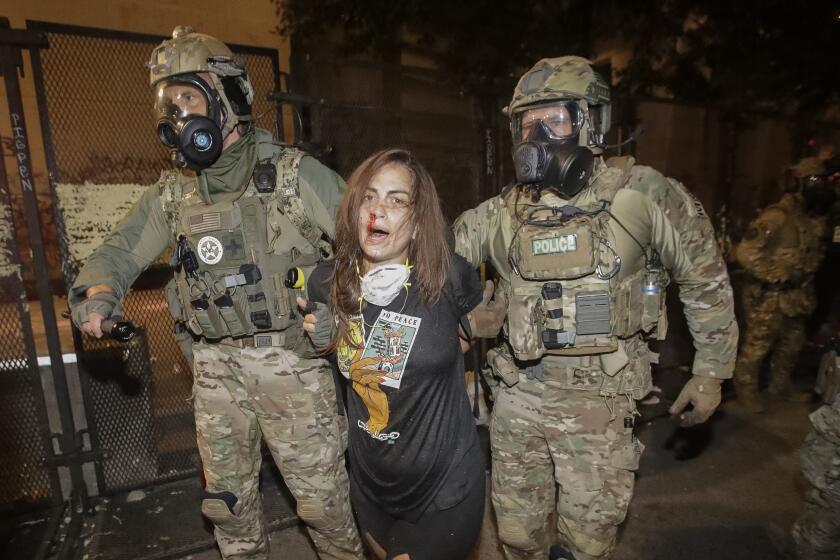Federal agents are arresting protesters in Portland. Officials say it’s legal

- Share via
PORTLAND, Ore. — The Trump administration pushed back Tuesday against allegations that unidentified federal agents have been roaming the streets here in unmarked cars and illegally detaining peaceful protesters.
“We are not patrolling the streets of Portland, as has been falsely reported multiple times in the last few days,” Chad Wolf, the acting secretary of the Department of Homeland Security, told reporters at a news conference in Washington.
Rather, he said, the agents were operating within the law and targeting “violent criminals” intent on destroying federal property that local officials refused to protect. He said 43 people had been arrested since July 4 but did not specify the charges against them.
After more than seven straight weeks of protests in a city known for its leftist politics, the presence of federal agents in Portland has become a flashpoint in a deepening national debate over civil liberties and what demonstrators and local officials view as an abuse of power by the Trump administration.
A federal judge in Portland has scheduled oral arguments Wednesday in a lawsuit filed Friday by Oregon Atty. Gen. Ellen Rosenblum, who is seeking a temporary restraining order blocking detentions by federal authorities without probable cause.
The actions of federal law enforcement officers at protests in Oregon’s largest city are raising the prospect of a constitutional crisis.
Accusing President Trump of waging the crackdown to make law and order a centerpiece of his reelection campaign, the state’s Democratic congressional delegation is trying to block deployment of unidentified federal agents to cities.
Trump’s “secret police ... take people away, they hold them, they interrogate them without justification and ultimately without charges,” Sen. Ron Wyden (D-Ore.) said on the Senate floor Tuesday.
“Donald Trump did not send this expeditionary force to keep people safe,” he said. “Donald Trump is doing this to create an image of chaos, to air them on far-right television, to scare the country and turn them into campaign ads.”
Oregon’s Democratic governor, Kate Brown, accused federal agents — or “Trump’s troops,” as she called them — of escalating the violence.
“The Trump administration is not interested in problem-solving,” she tweeted Tuesday. “The Trump administration is not interested in public safety. They are interested in political theater.”
An iconic image has emerged on Twitter since early Saturday morning in Portland, when a woman wearing nothing but a mask and cap strode toward federal agents as they fired tear gas at protesters — a surreal image of human vulnerability in the face of an overpowering force.
As the sun set Tuesday, activists cooked ribs, sausages and hot dogs at a sidewalk barbecue joint known as Riot Ribs, which serves free food to protesters, homeless people and anyone else who comes by.
Suddenly there was a roar from protesters gathered a block away in front of the Mark O. Hatfield U.S. Courthouse, graffiti-covered and boarded up.
Federal officers had darted out the front doors, grabbed a black-clad activist from the front steps and dragged the protester back into the building.
“The feds are proving our point for us,” said Alia Raven, an 18-year-old sorting first-aid supplies and pandemic masks near the barbecue. “We are out here protesting police brutality and promoting community self-care, and they use brutality to stop us.”
As they did across much of the United States, protests against racism and police brutality broke out in Portland shortly after the May 25 police killing of George Floyd in Minneapolis. But unlike in many other cities, the demonstrations have shown little sign of waning.
The protests usually begin as peaceful marches and rallies. But as the night wears on, federal agents and activists often wind up trading volleys of tear gas and projectiles. Then after midnight, activists typically tear down metal fencing and rip plywood off boarded-up buildings, and agents fire pepper balls and flash-bang munitions.
Richard Cline, deputy director of the Federal Protective Service, a Homeland Security Department agency that protects government property, told reporters at the news conference Tuesday that his Portland-based agents were quickly overwhelmed during early days of the demonstrations as protests turned violent and destructive.
He said the day was typical, explaining that at 3:29 a.m., activists tore plywood off the front of the courthouse, smashed a window and tried to throw commercial-grade fireworks at federal agents inside.
When agents went outside to push them back, activists tried to set a tree on fire and officers made seven arrests — two on suspicion of assaulting a federal officer and five for misdemeanors such as vandalism or failing to obey instructions, he said.
Wolf said that in addition to vandalizing the courthouse and another federal building, organized criminal elements operating independent of peaceful protesters have repeatedly attacked federal agents with baseball bats, commercial fireworks, glass bottles and lasers that have left three officers with potentially permanent loss of sight.
“These individuals are organized and they have one mission in mind,” he said. “To burn down or to cause extreme damage to the federal courthouse and to law enforcement officers.”
He said that officials in Portland have a history of refusing to defend federal property, including in 2018 when activists “laid siege” to a U.S. Immigration and Customs Enforcement office for 28 days.
“The fact that we are there is because local officials are not taking action, they are not helping to address the situation,” Wolf said, noting that the increased federal presence began around July 4.
Addressing the question of the legality of the arrests, Wolf said that with probable cause, federal agents are permitted to make targeted arrests away from U.S. property.
Mark Morgan, acting commissioner of U.S. Customs and Border Protection, said his agency dispatched special response teams, including U.S. Border Patrol officers trained to respond to mass protests and riots in detention facilities.
Observing protests from an incident command center, agents have “narrowly targeted” each arrest based on specific violent conduct, he said.
He said reports that uniforms were not properly marked were “lies and false rumors” and that each one is labeled “police” and displays identifying information, though recently numbers have been substituted for officers’ names because activists were tracing them to their homes.
The officials said the U.S. Department of Justice inspector general is investigating an incident widely seen in a video on Twitter in which federal marshals attacked a U.S. Navy veteran who appeared to offer no provocation.
Wolf also said he welcomed an investigation by the Homeland Security inspector general into another incident in which a protester reported being pulled into an unmarked vehicle, questioned and released — but he added that video evidence suggested no wrongdoing by officers.
He denied reports that the federal government was planning similar crackdowns in other cities, and said he remained willing to work with Oregon officials to deescalate the Portland strife and find a peaceful outcome.
“I’m willing to pull my officers out of there if the violence stops,” he said.
Times staff writer Read reported from Seattle and special correspondent Yau from Portland.
More to Read
Sign up for Essential California
The most important California stories and recommendations in your inbox every morning.
You may occasionally receive promotional content from the Los Angeles Times.












